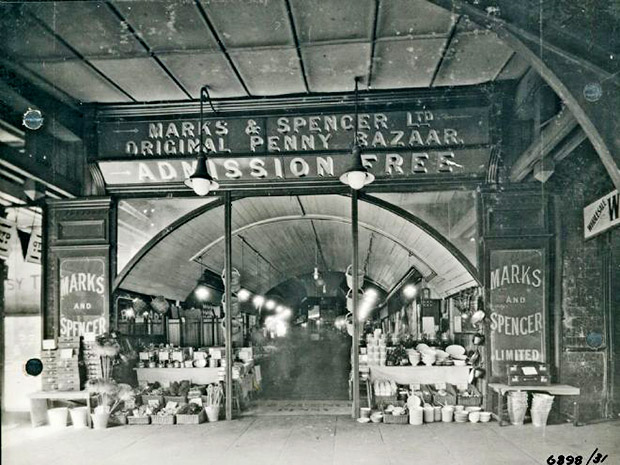Don't Ask the Price, it's a Penny!
Michael Marks arrived in Britain during the 1880s to escape the persecution of Jews in Russian Poland. In 1884 he set up a stall in Leeds' Kirkgate open market where he sold a range of household goods with a fixed price tag of one penny.

A Marks & Spencer Penny Bazaar
With the support of local wholesaler, Isaac Dewhirst, two further penny bazaars were opened in Castleford and Wakefield followed by stalls in Warrington, Birkenhead, Bolton and Manchester. Signs were placed across the stalls reading 'Don't ask the price, it's a penny'.
Spencer joins the business
Through Dewhirst, Marks was introduced to Tom Spencer, a cashier with Dewhirst. Marks and Spencer went into partnership in 1894 and acquired a permanent stall in Leeds' covered market. The new partnership continued to expand in the 1890s, opening stores in Birmingham, Newcastle-upon-Tyne, Cardiff, Bath, and London. Spencer took on responsibility for management of the partners' warehouse and Marks dealt with recruitment of staff to run the bazaars. With the advice of Dewhirst, Marks & Spencer bought their supplies directly from the manufacturers and avoided the cost of the middleman's profit. The direct purchase of goods from manufacturers was to become an important strategy for the company in the twentieth century.
Success and sadness
The 1900s saw stores on the high streets of towns where trade created higher profits. New shops were opened in Liverpool, Bradford, and Bristol. The partnership built on its successful first decade and became a 'company limited by shares' in June 1903, with the majority of the shares being held equally by Marks and Spencer. The company continued to grow and profits increased, but it was soon to suffer the loss of its founders. Spencer died in July 1905, and Marks died in December 1907 at the age of 48. The interests of the two families continued to be represented in the company by William Chapman (for the Spencer family) and Bernhard Steel (for the Marks family). Chapman became the leading board member in the company after Marks' death and opened further branches across the country.
Taking control
Under Chapman and Steel, Michael Marks' son, Simon, was eager to protect the interests of his family and its stake in the business. In 1909 Simon Marks objected to the issue of further shares in the company, as this would have reduced the level of influence the Marks family had. Difficulties in the boardroom continued and Steel resigned in 1912. Simon Marks proposed in 1915 that Alexander Isaacs and Israel Sieff should be elected directors, but with opposition led by Chapman, the motion failed when the directors did not vote with the required three to one majority in favour. Marks took Chapman to court over the issue and it was declared that a simple majority should be sufficient to elect new directors. The decision in favour of Marks marked the end of Chapman's control. Marks was voted chairman in August 1916 and Chapman retired from the board along with Thomas Spencer (son of Tom Spencer) in 1917.
After the death of his father, Simon Marks took control of a company that had expanded rapidly in the twenty years since the foundation of the Marks & Spencer partnership. The company had 145 branches trading across the country generating a turnover of £400,000. In 1926 the company was floated on the stock market.